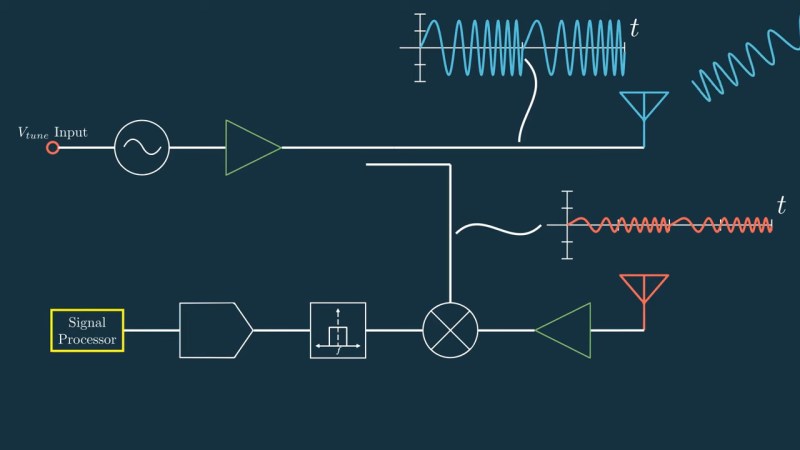
Pretty much every modern car has some driver assistance feature, such as lane departure and blind-spot warnings, or adaptive cruise control. They’re all pretty cool, and they all depend on the car knowing where it is in space relative to other vehicles, obstacles, and even pedestrians. And they all have another thing in common: tiny radar sensors sprinkled around the car. But how in the world do they work?
If you’ve pondered that question, perhaps after nearly avoiding rear-ending another car, you’ll want to check out [Marshall Bruner]’s excellent series on the fundamentals of FMCW radar. The linked videos below are the first two installments. The first covers the basic concepts of frequency-modulated continuous wave systems, including the advantages they offer over pulsed radar systems. These advantages make them a great choice for compact sensors for the often chaotic automotive environment, as well as tasks like presence sensing and factory automation. The take-home for us was the steep penalty in terms of average output power on traditional pulsed radar systems thanks to the brief time the radar is transmitting. FMCW radars, which transmit and receive simultaneously, don’t suffer from this problem and can therefore be much more compact.
But how does sending and receiving at the same time actually give the desired information like range and velocity? That’s explained in the second video, which details a conceptual implementation of an FMCW radar. We’ll leave the full explanation to [Marshall], but briefly, the transmit section includes a signal generator that produces an FM carrier modulated with a sawtooth or triangular wave. That signal is transmitted out into space while also being sent to the receiver stage, where it’s mixed with the reflected wave arriving sometime later. The difference in frequency between the two signals, which isn’t due to the Doppler effect but rather the fact that the transmitted signal’s frequency changes with time, is the beat frequency needed for the FMCW radar equation. That along with a little — OK, probably a lot — of Fast Fourier Transform magic allows you to discriminate signals of interest from background features or random noise.
Will you be able to build an FMCW radar after watching [Marshall]’s videos? Probably not, but you don’t really need to; radar sensors are pretty easy to come by, enough so that we’ve seen teardowns on automotive radars and experiments with gesture sensing. But we really appreciate the primer, and we’re looking forward to future installments.
No comments:
Post a Comment